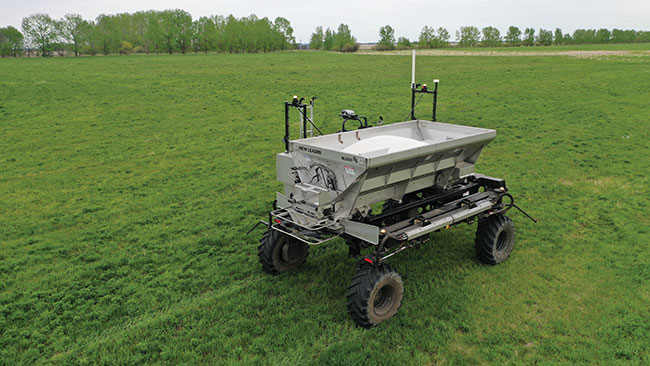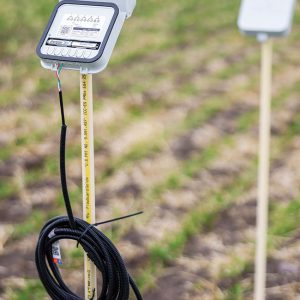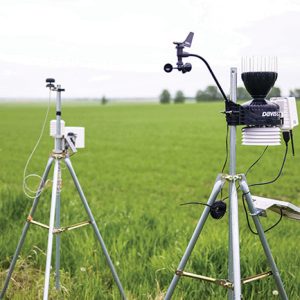
Features
Spreading for the future
Newer advanced technology can improve efficiency and environmental sustainability
February 11, 2022 by Donna Fleury
 OMNiPOWER, the autonomous platform, performing a mission of applying granular fertilizer to a Smart Farm field.
ALL Photos courtesy of Olds College.
OMNiPOWER, the autonomous platform, performing a mission of applying granular fertilizer to a Smart Farm field.
ALL Photos courtesy of Olds College. Like other sectors, agriculture continues to benefit from new technology advancements and tools for nutrient management, cropping systems and best practices. Combining good management with precision agriculture and fit for purpose technology tools can help improve nutrient use efficiency, profitability and environmental sustainability on the farm.
“Understanding the terminology and the range of technology and tools is an important place to start,” explains Alex Melnitchouck, CTO-digital ag at Olds College in Olds, Alta. “Precision agriculture is a farming practice developed more than 20 years ago that uses geographical information systems or GPS, navigation and prescription mapping tools and other technologies to manage field variability. Applying variable rate technology (VRT) to manage the variability of yield and nutrient requirements in a field is an example of precision agriculture technology. Digital agriculture, another term implemented about eight years ago, is much broader and applies to using any digital technology for collecting and analyzing agriculture data for making farm decisions.”
Internet of Things, or IoT, refers to various devices connected to one Internet or communications network to solve different problems on the farm or manage better decisions. “Those devices connected to the internet can be almost anything, field sensors, sensors on implements, computers on field equipment, web data sources or other digital tools,” says Melnitchouck. “These various ‘things’ are connected into one integrated network where information can be quickly transferred from one part of the network to another and back and forth, and results in more efficient agricultural operations. An additional term is ‘smart agriculture,’ which is broader than digital agriculture, and includes any kind of innovation and technologies that go beyond digitalization, such as biotechnology, advanced crop protection tools, genomics and new food innovations.”
Although all of these new tools and technologies offer opportunities for agriculture operations, there remain some challenges. One of the biggest challenges for farmers and custom applicators in some rural areas is access to reliable cellular phone service and internet connections to be able to fully utilize many of these tools. Instead of being able to utilize tools in real time in the field, such as nutrient or fertilizer prescriptions, some farmers have to save the files to a memory card and then upload it to the tractor to see if it works. Melnitchouck remembers in the past when trying to share documents with colleagues it meant mailing floppy disks back and forth or using slow dialup internet, where today using tools such as Google Docs means documents can be shared, edited and discussed in real time from anywhere in the world.
“Not having reliable connectivity is inconvenient and time-consuming, and better Internet and networking capabilities will be a big boost for rural agriculture operations,” says Melnitchouck. “For sectors such as banking, entertainment and others, better networking and software development have opened huge opportunities for collaboration on connecting computers for transferring large amounts of data for these digital operations. For agriculture it is a bit tricky because without reliable Internet coverage in rural areas, technology and software developers are reluctant to invest in developing products and tools unless they can be used. This is beginning to change and hopefully in the near future all areas will have networking capability and multiple options to match their needs. Then the field display on the tractor will become similar to Google Docs with the capability of connecting and implementing all of the different products. Farmers will be able to use real time tools such as sensors and servers that can get results from the field, such as soil nutrient or moisture analysis, weed or disease detection and send the processed results back to the field equipment on the go.”
These new products and technology open exciting opportunities, however, there are fundamentals that must be addressed first. Agronomic decisions for precision agriculture or various digital tools require detailed and credible agronomic information from the outset. This may be field mapping based on yield potential or soil organic matter, soil test results, manure analysis, nutrient requirements and historical information. Once the various layers of information are developed, then precision agriculture and digital tools can be implemented. A second consideration is the hardware and engineering requirements to be able to utilize the data or information.
Melnitchouck emphasizes that good quality agronomic information and the science behind it is critical to making good decisions. “If you have good information and data going in, you will have good results coming out. However, as one of our industry experts Rob Saik points out, ‘poor agronomy plus precision agriculture means poor agronomy applied precisely’. So no matter what kind of digital technology or equipment you have, if there is not good agronomy or crop and livestock science behind it, then you won’t get the results expected. For example, to make a proper nutrient, manure or fertilizer rate recommendation, it is necessary to know the level of nutrients available in the soil and what the plants will be able to take up. The technology and hardware components should also be able to ensure very accurate application and rate changes of nutrients everywhere you want across the field.”
As with any new investment, it is important to do some background research, talk to industry experts and pencil out the math to see if a new digital technology or product is going to work for you. Although new technology may improve efficiency or make some operations easier, there may not be the return on investment (ROI) expected. “Let’s say on average a western Canadian farmer makes $200 per acre, then a new technology solution will need to deliver three times or five times to the grower,” he explains. “Therefore if somebody sells you something that costs $30/acre, then you will need to make at least $90 or $100 per acre using that technology for a good ROI. Make sure to get all the information you can before investing in a new technology or product and make sure it will be reliable, deliver what is promised and is right for your farming system. You can’t digitize wheat or canola or livestock, you still need boots on the ground and work with unpredictable mother nature in our farming systems.”
“Most of the new technologies are environmentally friendly in many ways and bring several benefits,” adds Melnitchouck. “Autosteer navigation on a tractor or combine or other machines, first available about 20 years ago, automatically steers very accurately straight back and forth, which reduces overlaps or gaps between passes. For nutrient application, autosteer can reduce fuel use by five per cent and nutrient use by five per cent because of no overlaps. Without any regulations or new requirements, the new technology improves efficiency by five per cent and can contribute to greenhouse gas reductions and carbon credit management. Variable rate technology for nutrient application, whether that is organic fertilizer, manure or compost applications, can also increase nutrient efficiency by five or 10 per cent or even more by applying nutrients at the right rate, at the right time in the right way in combination with the right agronomy. And again without any regulation but just by using newer advanced technology that makes a farming system more efficient and environmentally friendly.”
Over the next few years, Melnitchouck expects to see digitalization, automation and machine learning in ag evolve. Automation will make farming decisions more convenient and more efficient. At the Smart Farm, one priority is collecting a range of data for training and developing predictive algorithms. “We are collecting ‘Hyper Layer’ data from various fields including biophysical and physical characteristics of soils and plants, yield, imagery and many other data points. However, unlike in math or physics that work with exact numbers, in agriculture we have to work with probabilities. Once the right sources of data are collected and all of that information is managed properly, then the probability of success goes higher and higher. The purpose of the data collection is to be able to automate certain decision making procedures and certain algorithms to make farming decisions more efficient. Essentially everything that can be explained verbally can be automated.”
Olds College continues to focus on applied research and demonstration of many new digital and IoT technologies through their Smart Farm Program together with industry collaborators. It have also scaled programs and courses for students, with a new Ag Tech program and more than 35 new courses to help develop the skills and talent to commercialize and scale reliable new technologies. Farmers adopting newer advanced technology that are compatible with their operations for nutrient planning, monitoring and application, as well as many other cropping system practices can make their farming systems more efficient and environmentally friendly.

